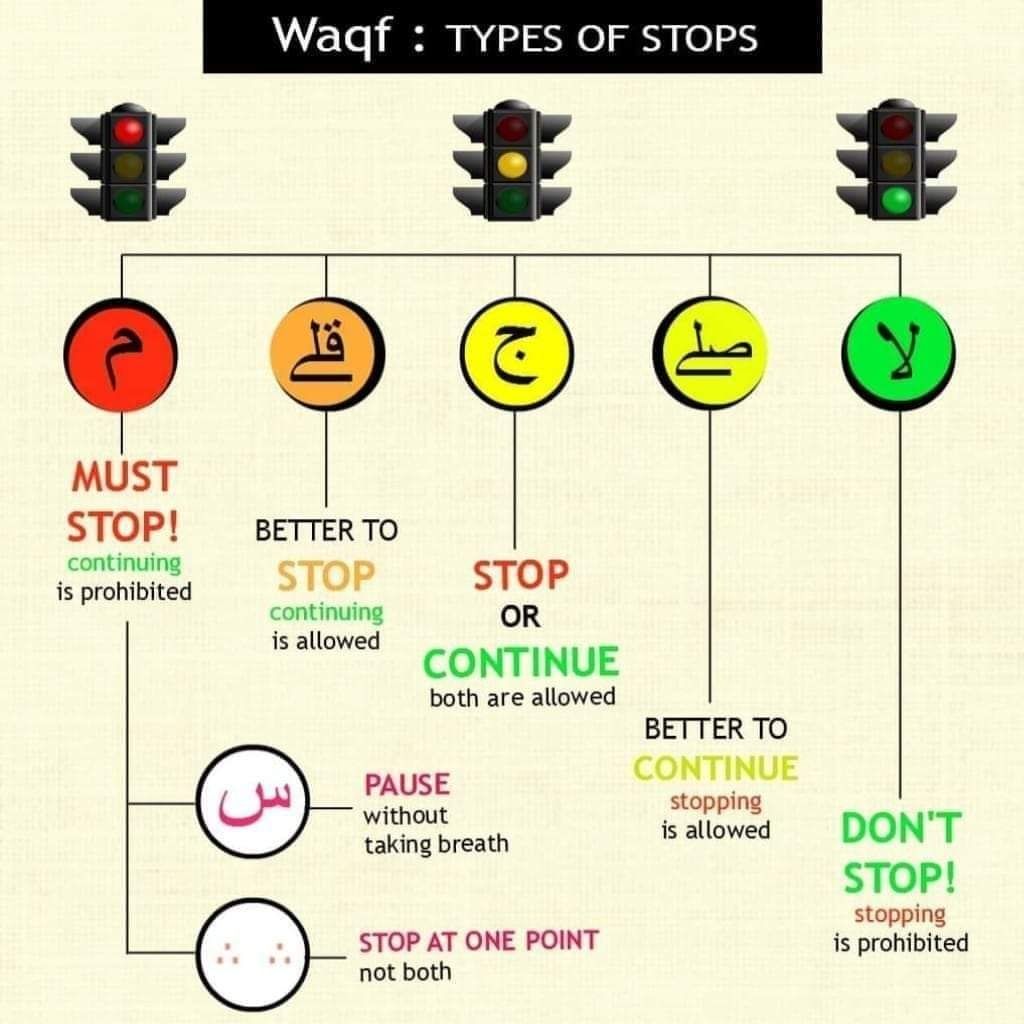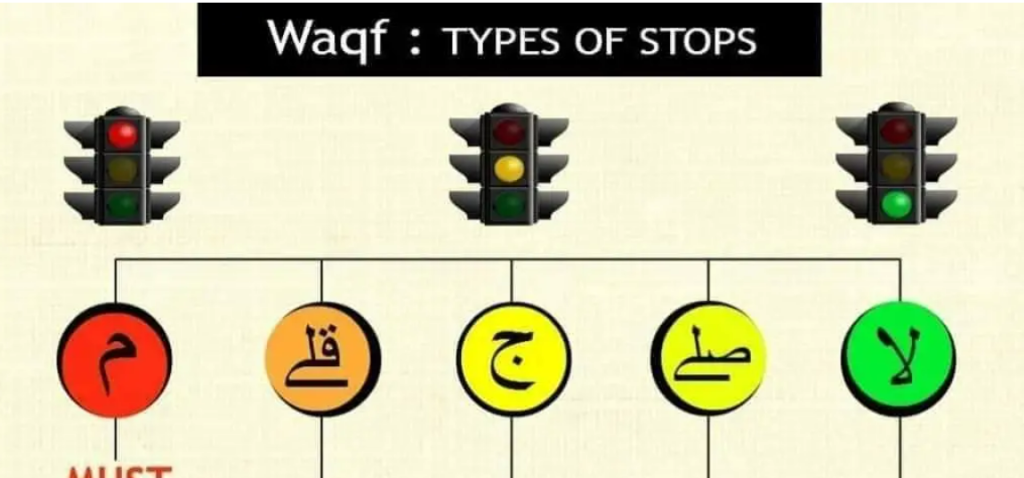The Quran, as the holy book of Islam, holds a profound place in the lives of Muslims around the world. As an essential aspect of the Islamic faith, the Quran is recited in its original Arabic text, and to preserve its intended meanings and enhance recitation, special symbols known as waqf (Stopping symbols in the Quran) guide readers on where to pause, stop, or continue. These symbols help maintain the flow and meaning of the verses, and understanding them is key to proper recitation.
In this blog, we’ll explore the importance of Stopping symbols in the Quran, examine the various types of symbols used, and provide answers to frequently asked questions on how to apply them during recitation.
Why Are Stopping Symbols Important in the Quran?
The Arabic language, like many languages, relies on punctuation and pauses to convey meaning accurately. Stopping at the wrong places can change the meaning of a sentence or phrase, which is particularly sensitive in the Quran due to its divine origin.

The Stopping symbols in the Quran help reciters pause at appropriate moments, preserving the coherence, rhythm, and divine message of the verses. Additionally, these symbols aid in the melodic flow, which is important for those reciting the Quran in a melodious, rhythmic manner known as tajweed.
Stopping symbols in the Quran
The most common Stopping symbols in the Quran, known collectively as waqf symbols, are placed within the text by scholars of Quranic recitation. Here are some of the primary symbols and their meanings:
-
م (Meem) – Mandatory Stop
The meem symbol indicates that stopping at this point is necessary. Continuing without stopping could potentially alter the meaning. Pausing here emphasizes the intended message and structure of the verse.
-
لا (La) – No Stop
The la symbol advises against stopping. Pausing here might disrupt the flow and potentially alter the meaning, so reciters should continue to the next suitable stopping point.
-
ج (Jeem) – Permissible Stop
The jeem symbol suggests that stopping is allowed but not mandatory. Reciters can choose to stop if needed or continue if they prefer to maintain the rhythm of the verse.
-
ط (Ta) – Absolute Stop
The ta symbol indicates a strong recommendation to stop, often found at the end of complete sentences or ideas. Stopping here is often considered preferable for reflecting on the meaning.
-
قلى (Qala) – Stop Preferred Over Continuation
The qala symbol suggests that stopping here is preferable but not mandatory. It gives the reciter an option but gently encourages a pause.
-
صلى (Sili) – Continue Preferred Over Stop
The sili symbol, by contrast, suggests that continuing is preferable to stopping, though pausing is not forbidden.
-
سكتة (Saktah) – Brief Pause
The saktah symbol indicates a very brief pause without taking a breath. It is typically used to subtly separate words while maintaining the verse’s flow.
-
وقف معانقة (Waqf Mu‘anqah) – Conjoined Pause
This symbol appears as three small dots, usually placed between two words. It allows reciters to stop at one of the two points marked with dots, ensuring the meaning remains intact.
How to Properly Stop and Resume in Longer Ayahs?
In reciting longer ayahs in the Quran, knowing how to stop (waqf) and resume (ibtida’) properly is essential for preserving meaning and flow.

Here are some guidelines for proper Stopping symbols in the Quran and resuming:
1. Understanding Types of Stops:
- Waqf Taam (Complete Stop): This occurs at the natural end of a topic or meaning. You can be Stopping symbols in the Quran here without losing the context, as the next portion often introduces a new subject or idea.
- Waqf Kafi (Sufficient Stop): The meaning is complete, but the next part is related in context. It’s acceptable to stop here and then resume with the following phrase.
- Waqf Hasan (Good Stop): A grammatically acceptable pause where the meaning is understood, but it’s preferable to continue if possible for clarity.
- Waqf Qabiih (Improper Stop): This occurs when the meaning is left incomplete or could be misunderstood. Avoid stopping here.
2. Indicators in the Quran Text:
- Symbolic Indicators: Many printed Qurans have symbols like small letters or shapes to show good stopping points (م for mandatory stop, لا for avoiding a stop).
- Maddah and Tanween: Stopping at words with elongations (like maddah) or tanween (two vowels) can change pronunciation, often adding an “h” sound (such as from “tanween kasra” to “i”).
3. Techniques for Resuming After a Stop:
- Resume with the Previous Subject in Mind: Begin with a phrase that helps clarify or reiterate the context.
- Consider the Meaning: Always resume in a way that connects naturally to the previous statement, avoiding a disconnected or out-of-context resumption.
- Use of Basmalah (if needed): In very long pauses or new recitation sessions, beginning with “Bismillah” can aid in smooth resumption.
4. Practice and Familiarity:
- Tajweed Training: Studying with a teacher or using audio examples can help develop proper pauses and resumption points.
- Memorization Tips: Understanding the meaning aids in knowing where to pause comfortably without interrupting the message.
Stopping symbols in the Quran and resuming well can enhance the spiritual experience and ensure the message of the ayah is conveyed with its intended clarity and depth.
How to Use Stopping symbols in the Quran Correctly: A Step-by-Step Guide?
- Familiarize with Sy mbols: Begin by learning the symbols and their meanings. This understanding will give you a framework to approach each verse with confidence.
- Understand the Context: The context of the verse will often help decide whether stopping or continuing is best. If a sentence or phrase feels complete in meaning, it might be best to pause.
- Practice with a Teacher: Learning Quranic recitation under the guidance of a qualified teacher ensures that you grasp the nuances of the pauses. This hands-on approach allows you to correct mistakes in real-time.
- Apply the Rules Gradually: Start by focusing on the most common symbols (meem and jeem) and incorporate the others as you gain confidence.
- Reflect on the Meaning: Pausing at the right places not only preserves the meaning but allows for deeper reflection on the message of each verse.
Practical Tips for Memorizing and Reciting with Stopping Symbols

- Start with a Translation: If you’re not fluent in Arabic, reciting with a translation helps you understand where natural pauses might occur.
- Listen to Qualified Reciters: Listening to recitations by scholars or imams who follow stopping rules can help you intuitively pick up on where to stop.
- Use a Guidebook: Many Quranic copies come with a guide to stopping symbols in the introduction. Reviewing it can clarify specific symbols.
- Recite Slowly: When learning, avoid rushing. A slower pace gives you time to recognize each symbol and pause appropriately.
Conclusion
Stopping symbols in the Quran play a crucial role in guiding readers through the divine text with clarity and respect. They serve as checkpoints, maintaining the flow of meaning and ensuring that the words of the Quran are recited as intended. While these Stopping symbols in the Quran might seem daunting to beginners, with practice and patience, they become second nature. As you grow more familiar with the Quran, you’ll find that these symbols enrich your recitation, helping you connect more deeply with the message of Islam.
(FAQ)
Q1: Can I skip the stopping symbols if I find them confusing?
A1: While it may be tempting to skip over stopping symbols, especially when new to Quranic recitation, it’s advisable to learn and apply them gradually. Stopping symbols helps maintain the correct meaning, so avoiding them might lead to misinterpretations. Start with the most essential symbols and practice over time.
Q2: What if I accidentally stop at a “No Stop” symbol?
A2: If you mistakenly stop at a “No Stop” (la) symbol, simply continue with the recitation, maintaining awareness of the next stopping points. Mistakes happen, and with practice, you’ll become more comfortable recognizing the symbols during recitation.
Q3: Are there stopping symbols at the end of every verse?
A3: Not every verse ends with a stopping symbol, as some verses naturally contain a complete meaning by themselves. In general, however, the end of a verse typically serves as a pause point, especially in longer passages.
Q4: What’s the difference between “Mandatory Stop” and “Absolute Stop”?
A4: Both symbols encourage stopping, but a “Mandatory Stop” (meem) is essential to maintaining the meaning, while an “Absolute Stop” (ta) is strongly recommended but might allow continuation in certain contexts. The emphasis on stopping is more pronounced with meem.

